Report: Managing Communication, Knowledge and Information for Baggit
VerifiedAdded on 2019/12/28
|12
|3513
|149
Report
AI Summary
This report delves into the critical aspects of managing communication, knowledge, and information within organizations. It begins by exploring the range of decisions, information requirements, and sources of information, using Baggit as a case study for its expansion into London. The report then exa...
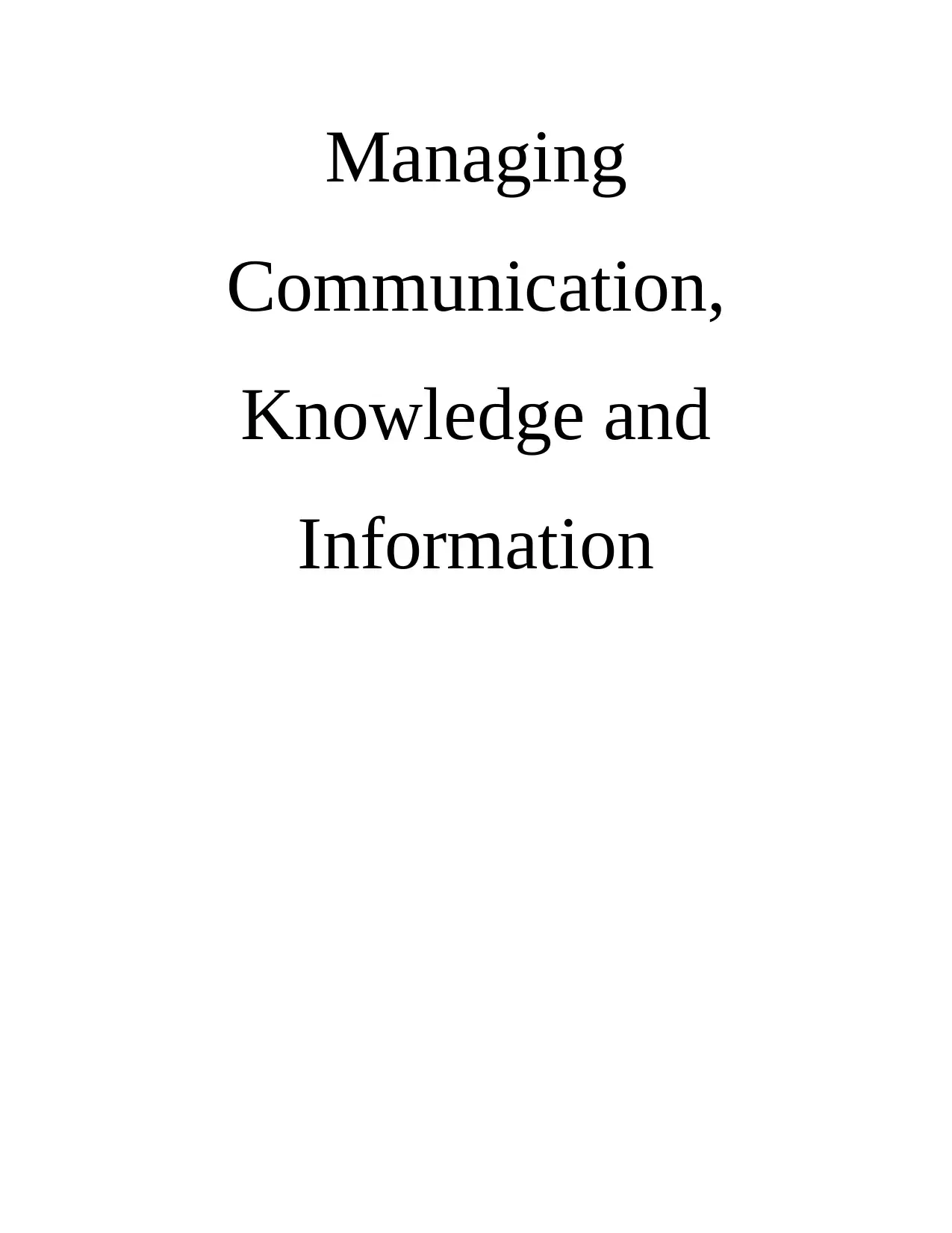
Managing
Communication,
Knowledge and
Information
Communication,
Knowledge and
Information
Paraphrase This Document
Need a fresh take? Get an instant paraphrase of this document with our AI Paraphraser
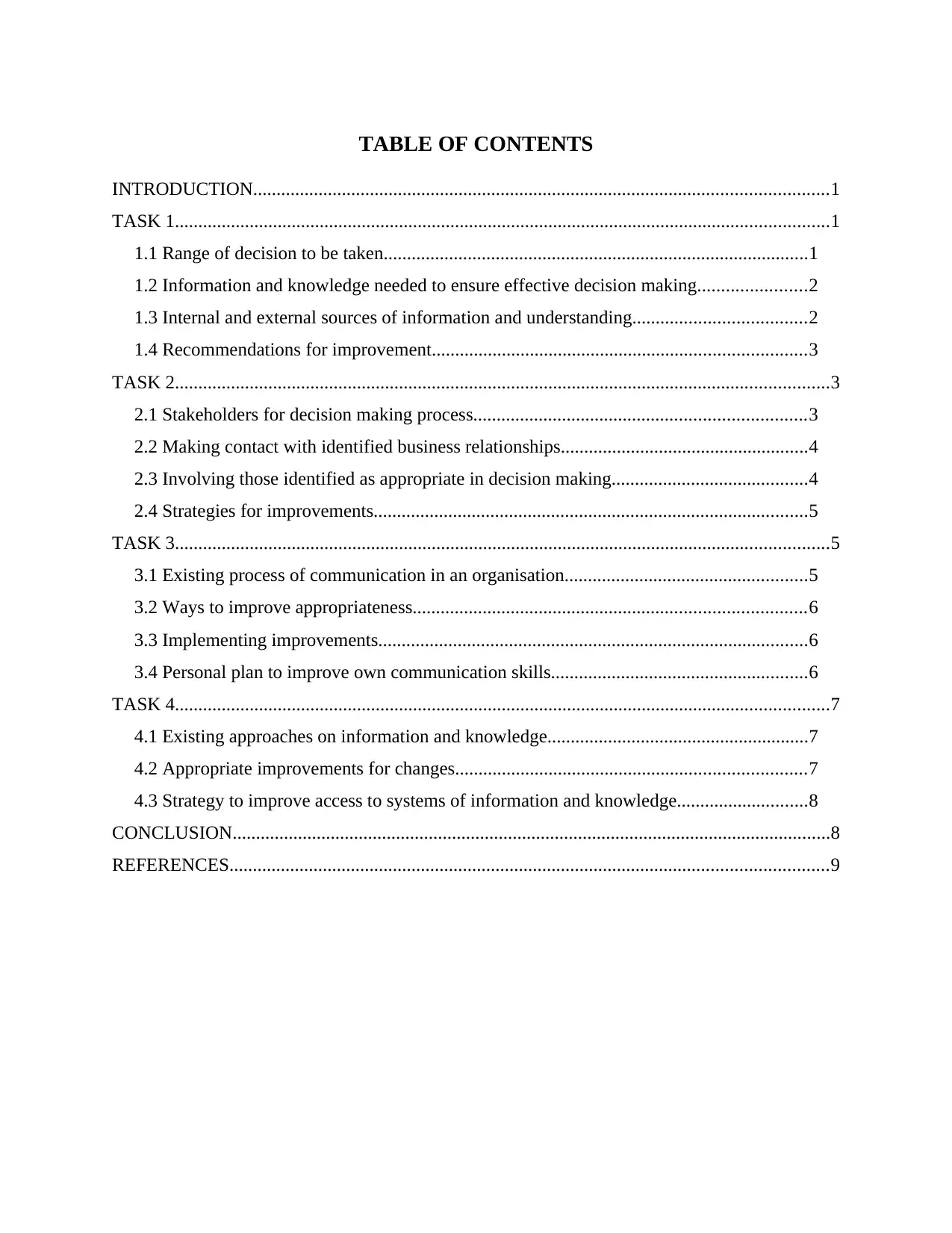
TABLE OF CONTENTS
INTRODUCTION...........................................................................................................................1
TASK 1............................................................................................................................................1
1.1 Range of decision to be taken...........................................................................................1
1.2 Information and knowledge needed to ensure effective decision making.......................2
1.3 Internal and external sources of information and understanding.....................................2
1.4 Recommendations for improvement................................................................................3
TASK 2............................................................................................................................................3
2.1 Stakeholders for decision making process.......................................................................3
2.2 Making contact with identified business relationships.....................................................4
2.3 Involving those identified as appropriate in decision making..........................................4
2.4 Strategies for improvements.............................................................................................5
TASK 3............................................................................................................................................5
3.1 Existing process of communication in an organisation....................................................5
3.2 Ways to improve appropriateness....................................................................................6
3.3 Implementing improvements............................................................................................6
3.4 Personal plan to improve own communication skills.......................................................6
TASK 4............................................................................................................................................7
4.1 Existing approaches on information and knowledge........................................................7
4.2 Appropriate improvements for changes...........................................................................7
4.3 Strategy to improve access to systems of information and knowledge............................8
CONCLUSION................................................................................................................................8
REFERENCES................................................................................................................................9
INTRODUCTION...........................................................................................................................1
TASK 1............................................................................................................................................1
1.1 Range of decision to be taken...........................................................................................1
1.2 Information and knowledge needed to ensure effective decision making.......................2
1.3 Internal and external sources of information and understanding.....................................2
1.4 Recommendations for improvement................................................................................3
TASK 2............................................................................................................................................3
2.1 Stakeholders for decision making process.......................................................................3
2.2 Making contact with identified business relationships.....................................................4
2.3 Involving those identified as appropriate in decision making..........................................4
2.4 Strategies for improvements.............................................................................................5
TASK 3............................................................................................................................................5
3.1 Existing process of communication in an organisation....................................................5
3.2 Ways to improve appropriateness....................................................................................6
3.3 Implementing improvements............................................................................................6
3.4 Personal plan to improve own communication skills.......................................................6
TASK 4............................................................................................................................................7
4.1 Existing approaches on information and knowledge........................................................7
4.2 Appropriate improvements for changes...........................................................................7
4.3 Strategy to improve access to systems of information and knowledge............................8
CONCLUSION................................................................................................................................8
REFERENCES................................................................................................................................9
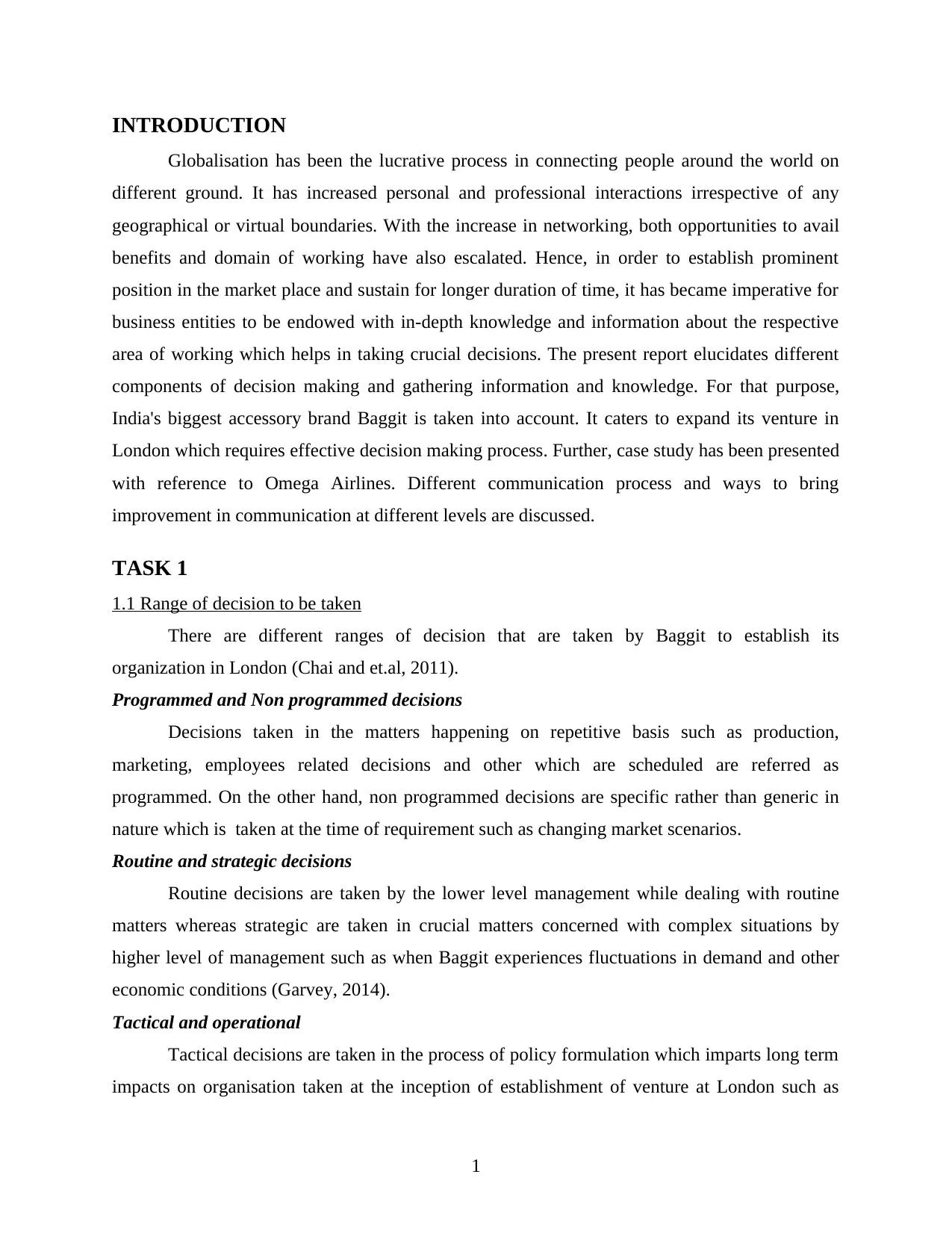
INTRODUCTION
Globalisation has been the lucrative process in connecting people around the world on
different ground. It has increased personal and professional interactions irrespective of any
geographical or virtual boundaries. With the increase in networking, both opportunities to avail
benefits and domain of working have also escalated. Hence, in order to establish prominent
position in the market place and sustain for longer duration of time, it has became imperative for
business entities to be endowed with in-depth knowledge and information about the respective
area of working which helps in taking crucial decisions. The present report elucidates different
components of decision making and gathering information and knowledge. For that purpose,
India's biggest accessory brand Baggit is taken into account. It caters to expand its venture in
London which requires effective decision making process. Further, case study has been presented
with reference to Omega Airlines. Different communication process and ways to bring
improvement in communication at different levels are discussed.
TASK 1
1.1 Range of decision to be taken
There are different ranges of decision that are taken by Baggit to establish its
organization in London (Chai and et.al, 2011).
Programmed and Non programmed decisions
Decisions taken in the matters happening on repetitive basis such as production,
marketing, employees related decisions and other which are scheduled are referred as
programmed. On the other hand, non programmed decisions are specific rather than generic in
nature which is taken at the time of requirement such as changing market scenarios.
Routine and strategic decisions
Routine decisions are taken by the lower level management while dealing with routine
matters whereas strategic are taken in crucial matters concerned with complex situations by
higher level of management such as when Baggit experiences fluctuations in demand and other
economic conditions (Garvey, 2014).
Tactical and operational
Tactical decisions are taken in the process of policy formulation which imparts long term
impacts on organisation taken at the inception of establishment of venture at London such as
1
Globalisation has been the lucrative process in connecting people around the world on
different ground. It has increased personal and professional interactions irrespective of any
geographical or virtual boundaries. With the increase in networking, both opportunities to avail
benefits and domain of working have also escalated. Hence, in order to establish prominent
position in the market place and sustain for longer duration of time, it has became imperative for
business entities to be endowed with in-depth knowledge and information about the respective
area of working which helps in taking crucial decisions. The present report elucidates different
components of decision making and gathering information and knowledge. For that purpose,
India's biggest accessory brand Baggit is taken into account. It caters to expand its venture in
London which requires effective decision making process. Further, case study has been presented
with reference to Omega Airlines. Different communication process and ways to bring
improvement in communication at different levels are discussed.
TASK 1
1.1 Range of decision to be taken
There are different ranges of decision that are taken by Baggit to establish its
organization in London (Chai and et.al, 2011).
Programmed and Non programmed decisions
Decisions taken in the matters happening on repetitive basis such as production,
marketing, employees related decisions and other which are scheduled are referred as
programmed. On the other hand, non programmed decisions are specific rather than generic in
nature which is taken at the time of requirement such as changing market scenarios.
Routine and strategic decisions
Routine decisions are taken by the lower level management while dealing with routine
matters whereas strategic are taken in crucial matters concerned with complex situations by
higher level of management such as when Baggit experiences fluctuations in demand and other
economic conditions (Garvey, 2014).
Tactical and operational
Tactical decisions are taken in the process of policy formulation which imparts long term
impacts on organisation taken at the inception of establishment of venture at London such as
1
⊘ This is a preview!⊘
Do you want full access?
Subscribe today to unlock all pages.

Trusted by 1+ million students worldwide
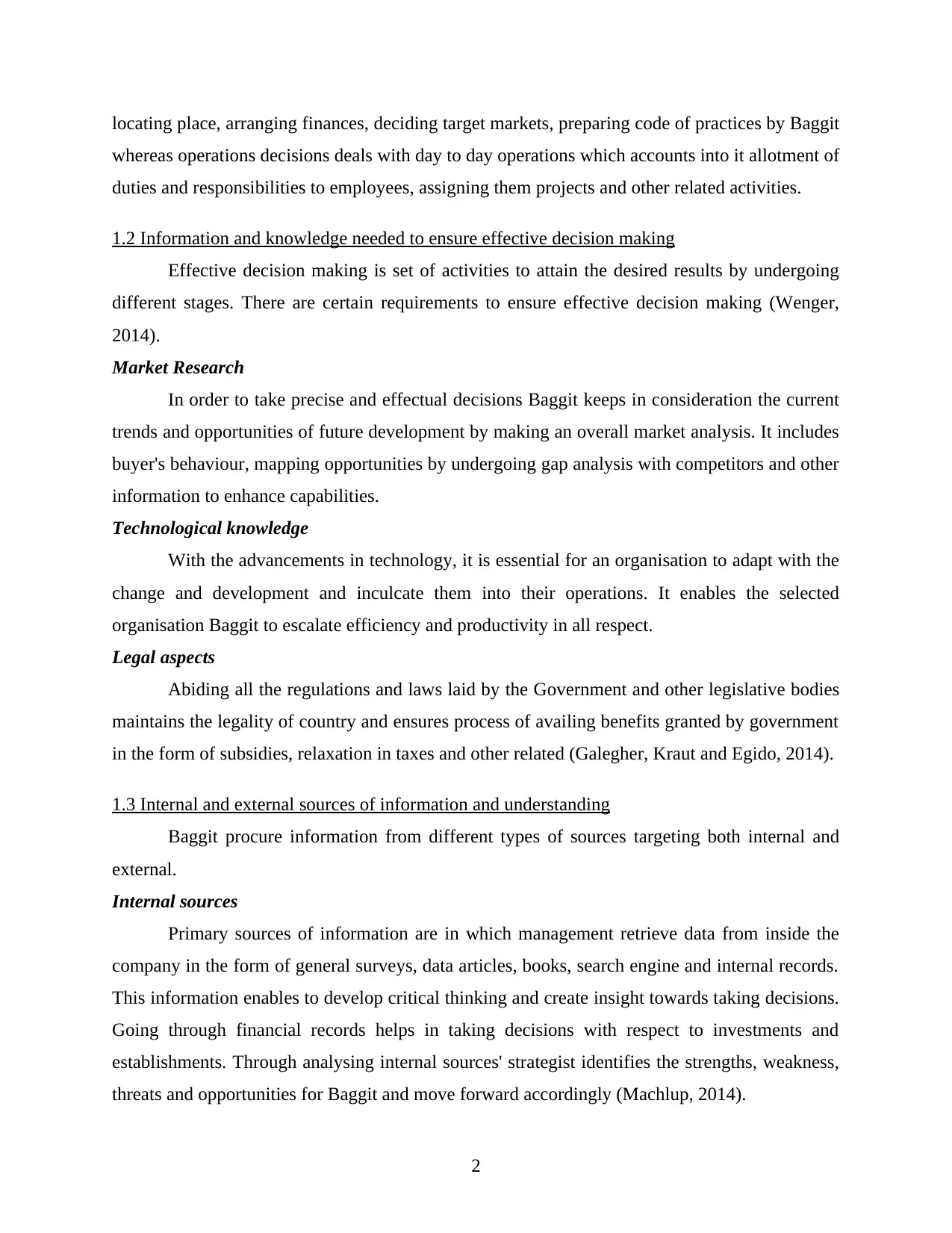
locating place, arranging finances, deciding target markets, preparing code of practices by Baggit
whereas operations decisions deals with day to day operations which accounts into it allotment of
duties and responsibilities to employees, assigning them projects and other related activities.
1.2 Information and knowledge needed to ensure effective decision making
Effective decision making is set of activities to attain the desired results by undergoing
different stages. There are certain requirements to ensure effective decision making (Wenger,
2014).
Market Research
In order to take precise and effectual decisions Baggit keeps in consideration the current
trends and opportunities of future development by making an overall market analysis. It includes
buyer's behaviour, mapping opportunities by undergoing gap analysis with competitors and other
information to enhance capabilities.
Technological knowledge
With the advancements in technology, it is essential for an organisation to adapt with the
change and development and inculcate them into their operations. It enables the selected
organisation Baggit to escalate efficiency and productivity in all respect.
Legal aspects
Abiding all the regulations and laws laid by the Government and other legislative bodies
maintains the legality of country and ensures process of availing benefits granted by government
in the form of subsidies, relaxation in taxes and other related (Galegher, Kraut and Egido, 2014).
1.3 Internal and external sources of information and understanding
Baggit procure information from different types of sources targeting both internal and
external.
Internal sources
Primary sources of information are in which management retrieve data from inside the
company in the form of general surveys, data articles, books, search engine and internal records.
This information enables to develop critical thinking and create insight towards taking decisions.
Going through financial records helps in taking decisions with respect to investments and
establishments. Through analysing internal sources' strategist identifies the strengths, weakness,
threats and opportunities for Baggit and move forward accordingly (Machlup, 2014).
2
whereas operations decisions deals with day to day operations which accounts into it allotment of
duties and responsibilities to employees, assigning them projects and other related activities.
1.2 Information and knowledge needed to ensure effective decision making
Effective decision making is set of activities to attain the desired results by undergoing
different stages. There are certain requirements to ensure effective decision making (Wenger,
2014).
Market Research
In order to take precise and effectual decisions Baggit keeps in consideration the current
trends and opportunities of future development by making an overall market analysis. It includes
buyer's behaviour, mapping opportunities by undergoing gap analysis with competitors and other
information to enhance capabilities.
Technological knowledge
With the advancements in technology, it is essential for an organisation to adapt with the
change and development and inculcate them into their operations. It enables the selected
organisation Baggit to escalate efficiency and productivity in all respect.
Legal aspects
Abiding all the regulations and laws laid by the Government and other legislative bodies
maintains the legality of country and ensures process of availing benefits granted by government
in the form of subsidies, relaxation in taxes and other related (Galegher, Kraut and Egido, 2014).
1.3 Internal and external sources of information and understanding
Baggit procure information from different types of sources targeting both internal and
external.
Internal sources
Primary sources of information are in which management retrieve data from inside the
company in the form of general surveys, data articles, books, search engine and internal records.
This information enables to develop critical thinking and create insight towards taking decisions.
Going through financial records helps in taking decisions with respect to investments and
establishments. Through analysing internal sources' strategist identifies the strengths, weakness,
threats and opportunities for Baggit and move forward accordingly (Machlup, 2014).
2
Paraphrase This Document
Need a fresh take? Get an instant paraphrase of this document with our AI Paraphraser
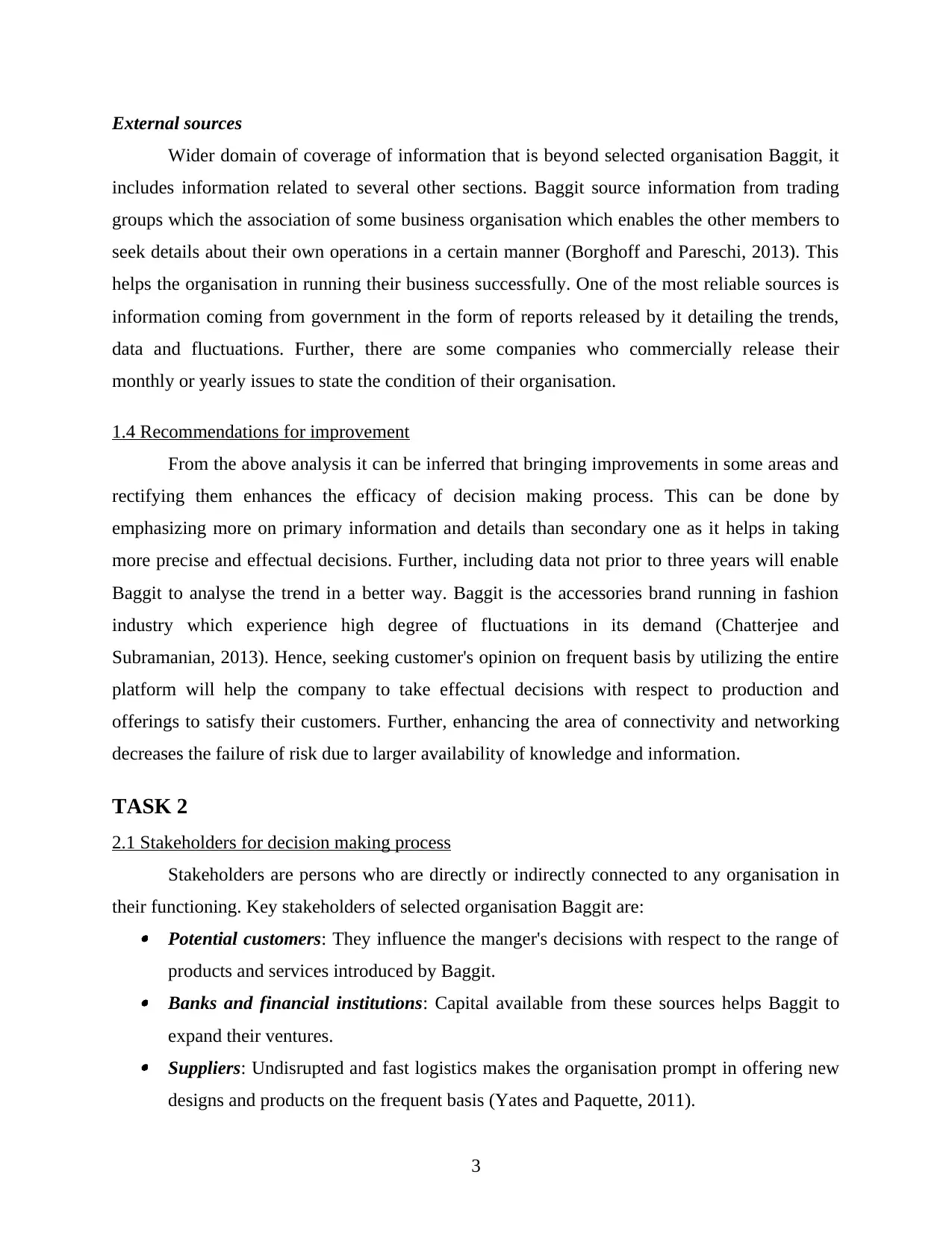
External sources
Wider domain of coverage of information that is beyond selected organisation Baggit, it
includes information related to several other sections. Baggit source information from trading
groups which the association of some business organisation which enables the other members to
seek details about their own operations in a certain manner (Borghoff and Pareschi, 2013). This
helps the organisation in running their business successfully. One of the most reliable sources is
information coming from government in the form of reports released by it detailing the trends,
data and fluctuations. Further, there are some companies who commercially release their
monthly or yearly issues to state the condition of their organisation.
1.4 Recommendations for improvement
From the above analysis it can be inferred that bringing improvements in some areas and
rectifying them enhances the efficacy of decision making process. This can be done by
emphasizing more on primary information and details than secondary one as it helps in taking
more precise and effectual decisions. Further, including data not prior to three years will enable
Baggit to analyse the trend in a better way. Baggit is the accessories brand running in fashion
industry which experience high degree of fluctuations in its demand (Chatterjee and
Subramanian, 2013). Hence, seeking customer's opinion on frequent basis by utilizing the entire
platform will help the company to take effectual decisions with respect to production and
offerings to satisfy their customers. Further, enhancing the area of connectivity and networking
decreases the failure of risk due to larger availability of knowledge and information.
TASK 2
2.1 Stakeholders for decision making process
Stakeholders are persons who are directly or indirectly connected to any organisation in
their functioning. Key stakeholders of selected organisation Baggit are: Potential customers: They influence the manger's decisions with respect to the range of
products and services introduced by Baggit. Banks and financial institutions: Capital available from these sources helps Baggit to
expand their ventures. Suppliers: Undisrupted and fast logistics makes the organisation prompt in offering new
designs and products on the frequent basis (Yates and Paquette, 2011).
3
Wider domain of coverage of information that is beyond selected organisation Baggit, it
includes information related to several other sections. Baggit source information from trading
groups which the association of some business organisation which enables the other members to
seek details about their own operations in a certain manner (Borghoff and Pareschi, 2013). This
helps the organisation in running their business successfully. One of the most reliable sources is
information coming from government in the form of reports released by it detailing the trends,
data and fluctuations. Further, there are some companies who commercially release their
monthly or yearly issues to state the condition of their organisation.
1.4 Recommendations for improvement
From the above analysis it can be inferred that bringing improvements in some areas and
rectifying them enhances the efficacy of decision making process. This can be done by
emphasizing more on primary information and details than secondary one as it helps in taking
more precise and effectual decisions. Further, including data not prior to three years will enable
Baggit to analyse the trend in a better way. Baggit is the accessories brand running in fashion
industry which experience high degree of fluctuations in its demand (Chatterjee and
Subramanian, 2013). Hence, seeking customer's opinion on frequent basis by utilizing the entire
platform will help the company to take effectual decisions with respect to production and
offerings to satisfy their customers. Further, enhancing the area of connectivity and networking
decreases the failure of risk due to larger availability of knowledge and information.
TASK 2
2.1 Stakeholders for decision making process
Stakeholders are persons who are directly or indirectly connected to any organisation in
their functioning. Key stakeholders of selected organisation Baggit are: Potential customers: They influence the manger's decisions with respect to the range of
products and services introduced by Baggit. Banks and financial institutions: Capital available from these sources helps Baggit to
expand their ventures. Suppliers: Undisrupted and fast logistics makes the organisation prompt in offering new
designs and products on the frequent basis (Yates and Paquette, 2011).
3
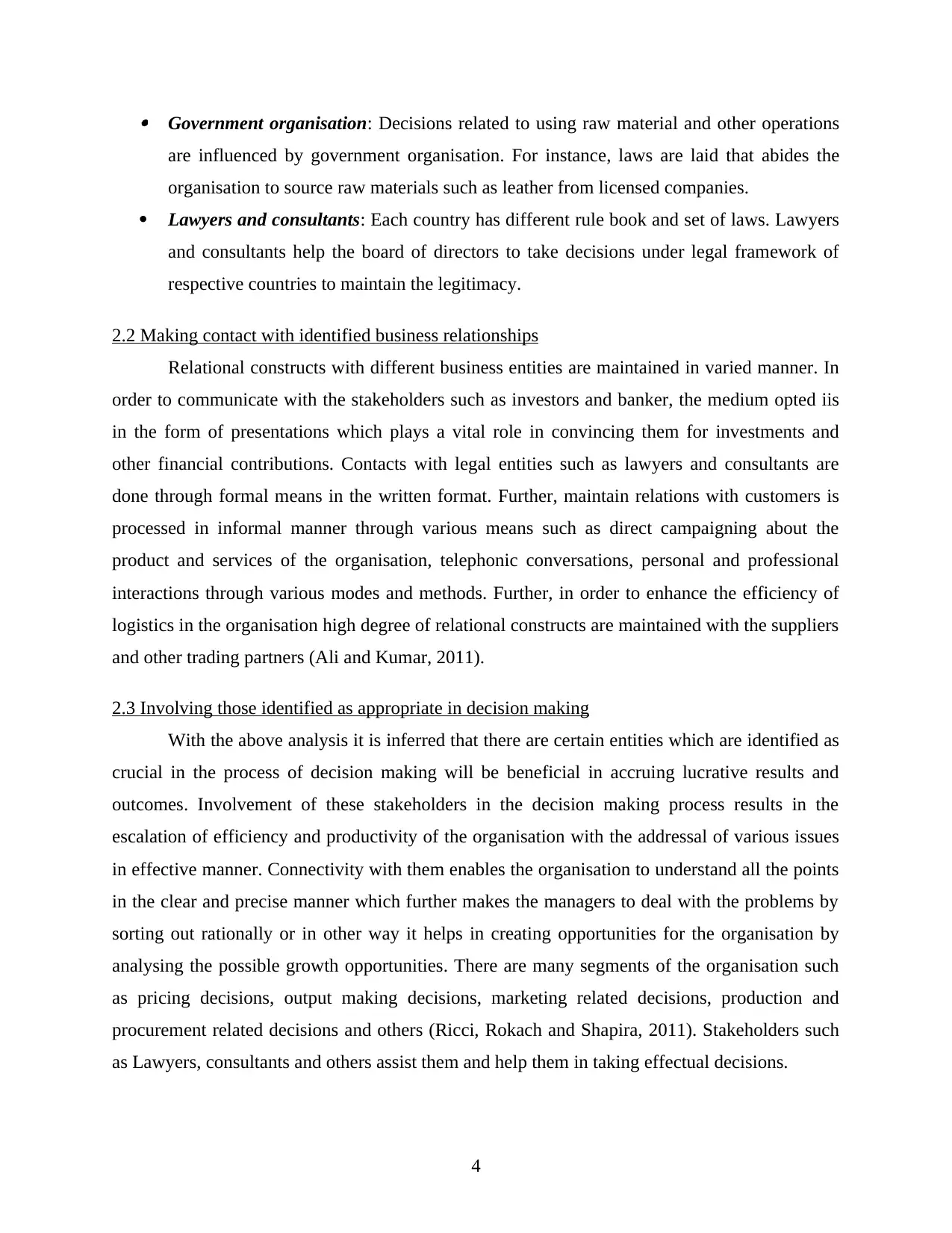
Government organisation: Decisions related to using raw material and other operations
are influenced by government organisation. For instance, laws are laid that abides the
organisation to source raw materials such as leather from licensed companies.
Lawyers and consultants: Each country has different rule book and set of laws. Lawyers
and consultants help the board of directors to take decisions under legal framework of
respective countries to maintain the legitimacy.
2.2 Making contact with identified business relationships
Relational constructs with different business entities are maintained in varied manner. In
order to communicate with the stakeholders such as investors and banker, the medium opted iis
in the form of presentations which plays a vital role in convincing them for investments and
other financial contributions. Contacts with legal entities such as lawyers and consultants are
done through formal means in the written format. Further, maintain relations with customers is
processed in informal manner through various means such as direct campaigning about the
product and services of the organisation, telephonic conversations, personal and professional
interactions through various modes and methods. Further, in order to enhance the efficiency of
logistics in the organisation high degree of relational constructs are maintained with the suppliers
and other trading partners (Ali and Kumar, 2011).
2.3 Involving those identified as appropriate in decision making
With the above analysis it is inferred that there are certain entities which are identified as
crucial in the process of decision making will be beneficial in accruing lucrative results and
outcomes. Involvement of these stakeholders in the decision making process results in the
escalation of efficiency and productivity of the organisation with the addressal of various issues
in effective manner. Connectivity with them enables the organisation to understand all the points
in the clear and precise manner which further makes the managers to deal with the problems by
sorting out rationally or in other way it helps in creating opportunities for the organisation by
analysing the possible growth opportunities. There are many segments of the organisation such
as pricing decisions, output making decisions, marketing related decisions, production and
procurement related decisions and others (Ricci, Rokach and Shapira, 2011). Stakeholders such
as Lawyers, consultants and others assist them and help them in taking effectual decisions.
4
are influenced by government organisation. For instance, laws are laid that abides the
organisation to source raw materials such as leather from licensed companies.
Lawyers and consultants: Each country has different rule book and set of laws. Lawyers
and consultants help the board of directors to take decisions under legal framework of
respective countries to maintain the legitimacy.
2.2 Making contact with identified business relationships
Relational constructs with different business entities are maintained in varied manner. In
order to communicate with the stakeholders such as investors and banker, the medium opted iis
in the form of presentations which plays a vital role in convincing them for investments and
other financial contributions. Contacts with legal entities such as lawyers and consultants are
done through formal means in the written format. Further, maintain relations with customers is
processed in informal manner through various means such as direct campaigning about the
product and services of the organisation, telephonic conversations, personal and professional
interactions through various modes and methods. Further, in order to enhance the efficiency of
logistics in the organisation high degree of relational constructs are maintained with the suppliers
and other trading partners (Ali and Kumar, 2011).
2.3 Involving those identified as appropriate in decision making
With the above analysis it is inferred that there are certain entities which are identified as
crucial in the process of decision making will be beneficial in accruing lucrative results and
outcomes. Involvement of these stakeholders in the decision making process results in the
escalation of efficiency and productivity of the organisation with the addressal of various issues
in effective manner. Connectivity with them enables the organisation to understand all the points
in the clear and precise manner which further makes the managers to deal with the problems by
sorting out rationally or in other way it helps in creating opportunities for the organisation by
analysing the possible growth opportunities. There are many segments of the organisation such
as pricing decisions, output making decisions, marketing related decisions, production and
procurement related decisions and others (Ricci, Rokach and Shapira, 2011). Stakeholders such
as Lawyers, consultants and others assist them and help them in taking effectual decisions.
4
⊘ This is a preview!⊘
Do you want full access?
Subscribe today to unlock all pages.

Trusted by 1+ million students worldwide
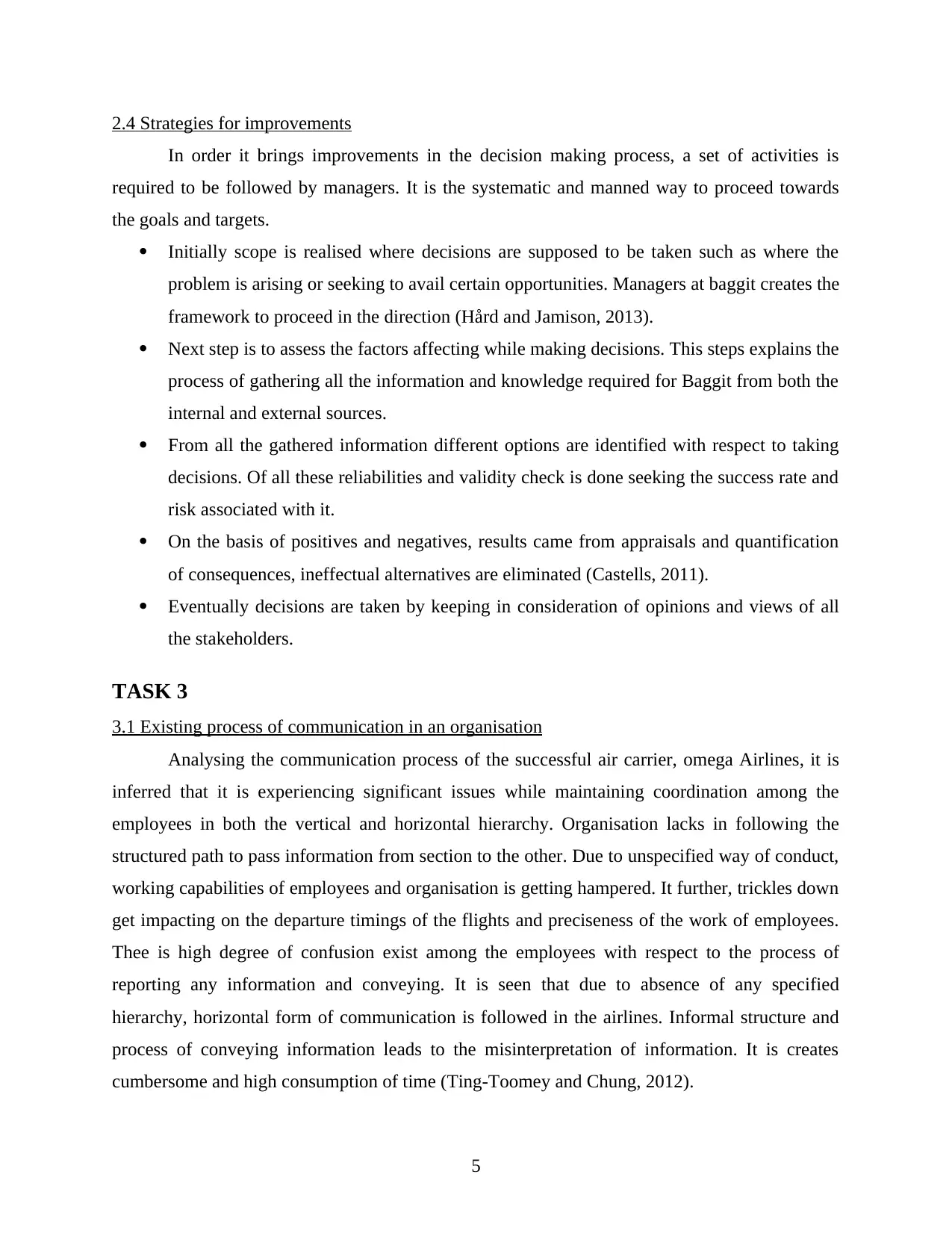
2.4 Strategies for improvements
In order it brings improvements in the decision making process, a set of activities is
required to be followed by managers. It is the systematic and manned way to proceed towards
the goals and targets.
Initially scope is realised where decisions are supposed to be taken such as where the
problem is arising or seeking to avail certain opportunities. Managers at baggit creates the
framework to proceed in the direction (Hård and Jamison, 2013).
Next step is to assess the factors affecting while making decisions. This steps explains the
process of gathering all the information and knowledge required for Baggit from both the
internal and external sources.
From all the gathered information different options are identified with respect to taking
decisions. Of all these reliabilities and validity check is done seeking the success rate and
risk associated with it.
On the basis of positives and negatives, results came from appraisals and quantification
of consequences, ineffectual alternatives are eliminated (Castells, 2011).
Eventually decisions are taken by keeping in consideration of opinions and views of all
the stakeholders.
TASK 3
3.1 Existing process of communication in an organisation
Analysing the communication process of the successful air carrier, omega Airlines, it is
inferred that it is experiencing significant issues while maintaining coordination among the
employees in both the vertical and horizontal hierarchy. Organisation lacks in following the
structured path to pass information from section to the other. Due to unspecified way of conduct,
working capabilities of employees and organisation is getting hampered. It further, trickles down
get impacting on the departure timings of the flights and preciseness of the work of employees.
Thee is high degree of confusion exist among the employees with respect to the process of
reporting any information and conveying. It is seen that due to absence of any specified
hierarchy, horizontal form of communication is followed in the airlines. Informal structure and
process of conveying information leads to the misinterpretation of information. It is creates
cumbersome and high consumption of time (Ting-Toomey and Chung, 2012).
5
In order it brings improvements in the decision making process, a set of activities is
required to be followed by managers. It is the systematic and manned way to proceed towards
the goals and targets.
Initially scope is realised where decisions are supposed to be taken such as where the
problem is arising or seeking to avail certain opportunities. Managers at baggit creates the
framework to proceed in the direction (Hård and Jamison, 2013).
Next step is to assess the factors affecting while making decisions. This steps explains the
process of gathering all the information and knowledge required for Baggit from both the
internal and external sources.
From all the gathered information different options are identified with respect to taking
decisions. Of all these reliabilities and validity check is done seeking the success rate and
risk associated with it.
On the basis of positives and negatives, results came from appraisals and quantification
of consequences, ineffectual alternatives are eliminated (Castells, 2011).
Eventually decisions are taken by keeping in consideration of opinions and views of all
the stakeholders.
TASK 3
3.1 Existing process of communication in an organisation
Analysing the communication process of the successful air carrier, omega Airlines, it is
inferred that it is experiencing significant issues while maintaining coordination among the
employees in both the vertical and horizontal hierarchy. Organisation lacks in following the
structured path to pass information from section to the other. Due to unspecified way of conduct,
working capabilities of employees and organisation is getting hampered. It further, trickles down
get impacting on the departure timings of the flights and preciseness of the work of employees.
Thee is high degree of confusion exist among the employees with respect to the process of
reporting any information and conveying. It is seen that due to absence of any specified
hierarchy, horizontal form of communication is followed in the airlines. Informal structure and
process of conveying information leads to the misinterpretation of information. It is creates
cumbersome and high consumption of time (Ting-Toomey and Chung, 2012).
5
Paraphrase This Document
Need a fresh take? Get an instant paraphrase of this document with our AI Paraphraser
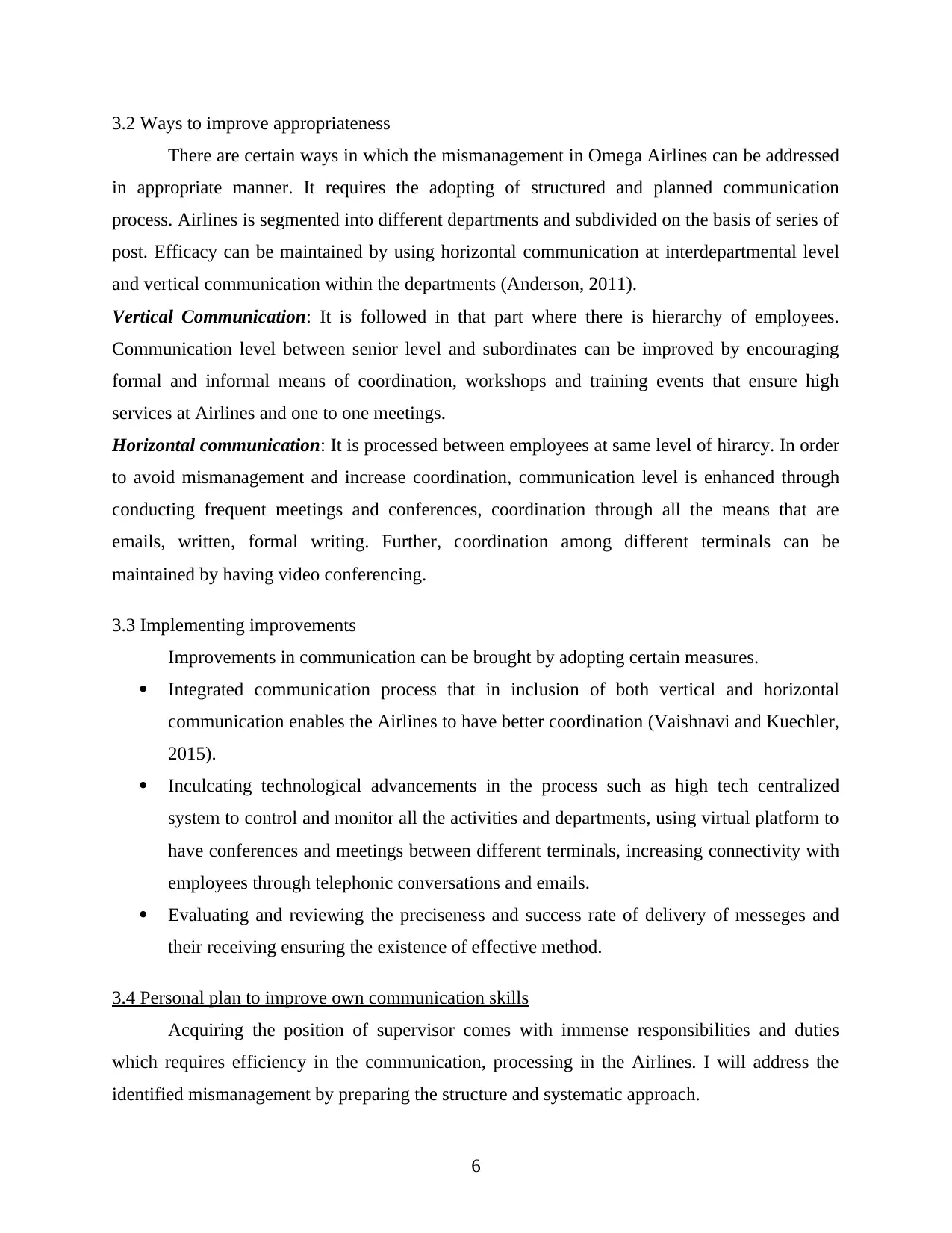
3.2 Ways to improve appropriateness
There are certain ways in which the mismanagement in Omega Airlines can be addressed
in appropriate manner. It requires the adopting of structured and planned communication
process. Airlines is segmented into different departments and subdivided on the basis of series of
post. Efficacy can be maintained by using horizontal communication at interdepartmental level
and vertical communication within the departments (Anderson, 2011).
Vertical Communication: It is followed in that part where there is hierarchy of employees.
Communication level between senior level and subordinates can be improved by encouraging
formal and informal means of coordination, workshops and training events that ensure high
services at Airlines and one to one meetings.
Horizontal communication: It is processed between employees at same level of hirarcy. In order
to avoid mismanagement and increase coordination, communication level is enhanced through
conducting frequent meetings and conferences, coordination through all the means that are
emails, written, formal writing. Further, coordination among different terminals can be
maintained by having video conferencing.
3.3 Implementing improvements
Improvements in communication can be brought by adopting certain measures.
Integrated communication process that in inclusion of both vertical and horizontal
communication enables the Airlines to have better coordination (Vaishnavi and Kuechler,
2015).
Inculcating technological advancements in the process such as high tech centralized
system to control and monitor all the activities and departments, using virtual platform to
have conferences and meetings between different terminals, increasing connectivity with
employees through telephonic conversations and emails.
Evaluating and reviewing the preciseness and success rate of delivery of messeges and
their receiving ensuring the existence of effective method.
3.4 Personal plan to improve own communication skills
Acquiring the position of supervisor comes with immense responsibilities and duties
which requires efficiency in the communication, processing in the Airlines. I will address the
identified mismanagement by preparing the structure and systematic approach.
6
There are certain ways in which the mismanagement in Omega Airlines can be addressed
in appropriate manner. It requires the adopting of structured and planned communication
process. Airlines is segmented into different departments and subdivided on the basis of series of
post. Efficacy can be maintained by using horizontal communication at interdepartmental level
and vertical communication within the departments (Anderson, 2011).
Vertical Communication: It is followed in that part where there is hierarchy of employees.
Communication level between senior level and subordinates can be improved by encouraging
formal and informal means of coordination, workshops and training events that ensure high
services at Airlines and one to one meetings.
Horizontal communication: It is processed between employees at same level of hirarcy. In order
to avoid mismanagement and increase coordination, communication level is enhanced through
conducting frequent meetings and conferences, coordination through all the means that are
emails, written, formal writing. Further, coordination among different terminals can be
maintained by having video conferencing.
3.3 Implementing improvements
Improvements in communication can be brought by adopting certain measures.
Integrated communication process that in inclusion of both vertical and horizontal
communication enables the Airlines to have better coordination (Vaishnavi and Kuechler,
2015).
Inculcating technological advancements in the process such as high tech centralized
system to control and monitor all the activities and departments, using virtual platform to
have conferences and meetings between different terminals, increasing connectivity with
employees through telephonic conversations and emails.
Evaluating and reviewing the preciseness and success rate of delivery of messeges and
their receiving ensuring the existence of effective method.
3.4 Personal plan to improve own communication skills
Acquiring the position of supervisor comes with immense responsibilities and duties
which requires efficiency in the communication, processing in the Airlines. I will address the
identified mismanagement by preparing the structure and systematic approach.
6
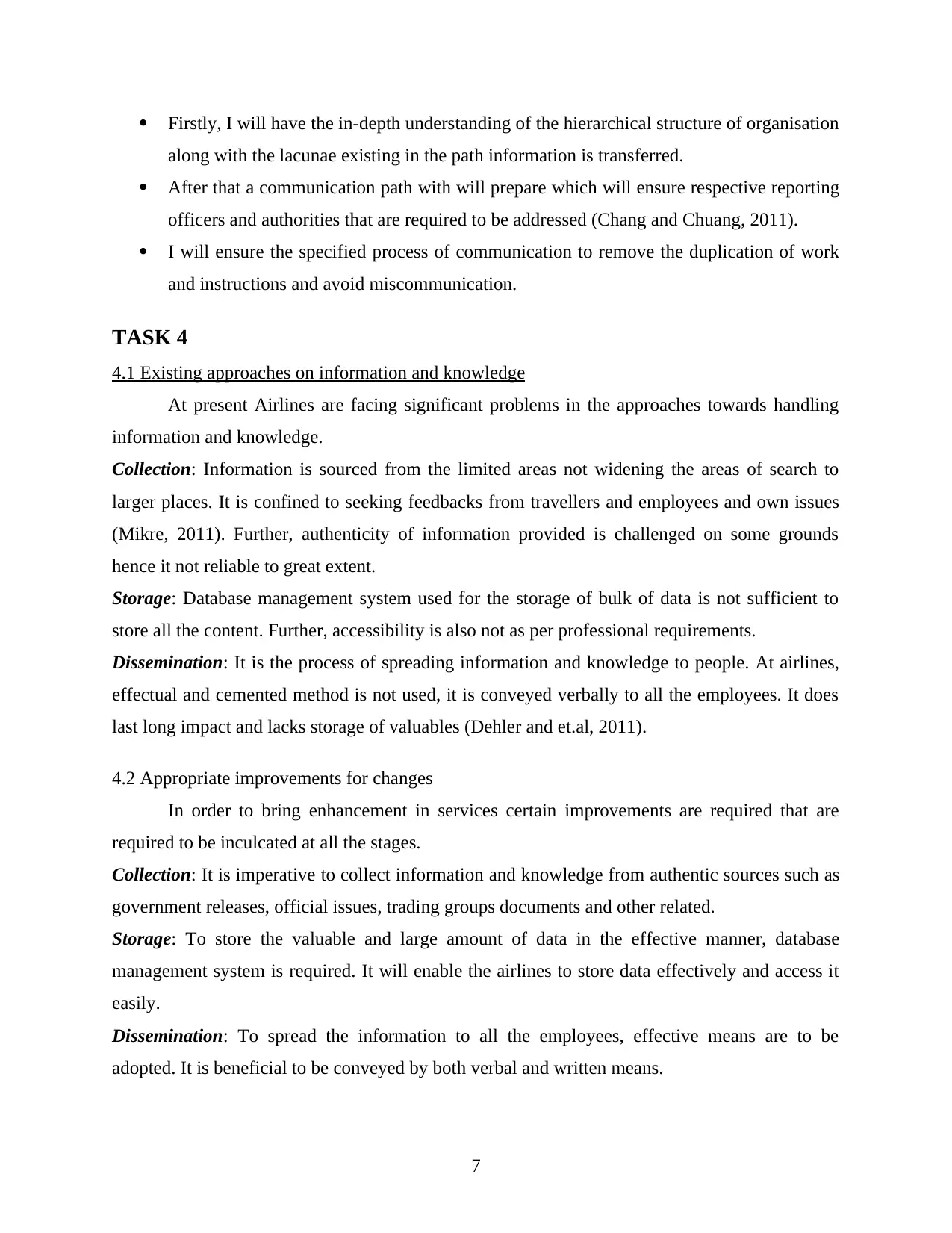
Firstly, I will have the in-depth understanding of the hierarchical structure of organisation
along with the lacunae existing in the path information is transferred.
After that a communication path with will prepare which will ensure respective reporting
officers and authorities that are required to be addressed (Chang and Chuang, 2011).
I will ensure the specified process of communication to remove the duplication of work
and instructions and avoid miscommunication.
TASK 4
4.1 Existing approaches on information and knowledge
At present Airlines are facing significant problems in the approaches towards handling
information and knowledge.
Collection: Information is sourced from the limited areas not widening the areas of search to
larger places. It is confined to seeking feedbacks from travellers and employees and own issues
(Mikre, 2011). Further, authenticity of information provided is challenged on some grounds
hence it not reliable to great extent.
Storage: Database management system used for the storage of bulk of data is not sufficient to
store all the content. Further, accessibility is also not as per professional requirements.
Dissemination: It is the process of spreading information and knowledge to people. At airlines,
effectual and cemented method is not used, it is conveyed verbally to all the employees. It does
last long impact and lacks storage of valuables (Dehler and et.al, 2011).
4.2 Appropriate improvements for changes
In order to bring enhancement in services certain improvements are required that are
required to be inculcated at all the stages.
Collection: It is imperative to collect information and knowledge from authentic sources such as
government releases, official issues, trading groups documents and other related.
Storage: To store the valuable and large amount of data in the effective manner, database
management system is required. It will enable the airlines to store data effectively and access it
easily.
Dissemination: To spread the information to all the employees, effective means are to be
adopted. It is beneficial to be conveyed by both verbal and written means.
7
along with the lacunae existing in the path information is transferred.
After that a communication path with will prepare which will ensure respective reporting
officers and authorities that are required to be addressed (Chang and Chuang, 2011).
I will ensure the specified process of communication to remove the duplication of work
and instructions and avoid miscommunication.
TASK 4
4.1 Existing approaches on information and knowledge
At present Airlines are facing significant problems in the approaches towards handling
information and knowledge.
Collection: Information is sourced from the limited areas not widening the areas of search to
larger places. It is confined to seeking feedbacks from travellers and employees and own issues
(Mikre, 2011). Further, authenticity of information provided is challenged on some grounds
hence it not reliable to great extent.
Storage: Database management system used for the storage of bulk of data is not sufficient to
store all the content. Further, accessibility is also not as per professional requirements.
Dissemination: It is the process of spreading information and knowledge to people. At airlines,
effectual and cemented method is not used, it is conveyed verbally to all the employees. It does
last long impact and lacks storage of valuables (Dehler and et.al, 2011).
4.2 Appropriate improvements for changes
In order to bring enhancement in services certain improvements are required that are
required to be inculcated at all the stages.
Collection: It is imperative to collect information and knowledge from authentic sources such as
government releases, official issues, trading groups documents and other related.
Storage: To store the valuable and large amount of data in the effective manner, database
management system is required. It will enable the airlines to store data effectively and access it
easily.
Dissemination: To spread the information to all the employees, effective means are to be
adopted. It is beneficial to be conveyed by both verbal and written means.
7
⊘ This is a preview!⊘
Do you want full access?
Subscribe today to unlock all pages.

Trusted by 1+ million students worldwide
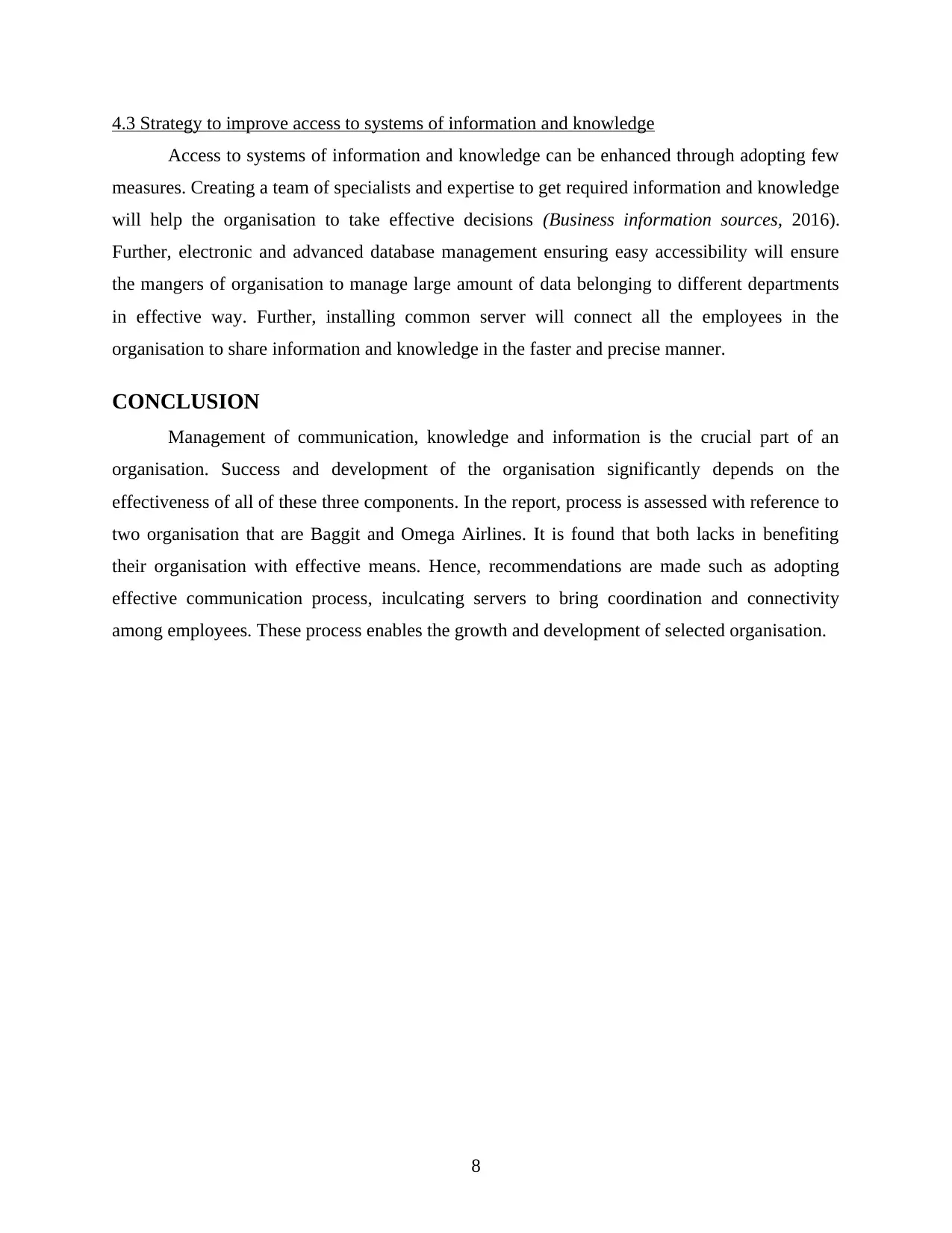
4.3 Strategy to improve access to systems of information and knowledge
Access to systems of information and knowledge can be enhanced through adopting few
measures. Creating a team of specialists and expertise to get required information and knowledge
will help the organisation to take effective decisions (Business information sources, 2016).
Further, electronic and advanced database management ensuring easy accessibility will ensure
the mangers of organisation to manage large amount of data belonging to different departments
in effective way. Further, installing common server will connect all the employees in the
organisation to share information and knowledge in the faster and precise manner.
CONCLUSION
Management of communication, knowledge and information is the crucial part of an
organisation. Success and development of the organisation significantly depends on the
effectiveness of all of these three components. In the report, process is assessed with reference to
two organisation that are Baggit and Omega Airlines. It is found that both lacks in benefiting
their organisation with effective means. Hence, recommendations are made such as adopting
effective communication process, inculcating servers to bring coordination and connectivity
among employees. These process enables the growth and development of selected organisation.
8
Access to systems of information and knowledge can be enhanced through adopting few
measures. Creating a team of specialists and expertise to get required information and knowledge
will help the organisation to take effective decisions (Business information sources, 2016).
Further, electronic and advanced database management ensuring easy accessibility will ensure
the mangers of organisation to manage large amount of data belonging to different departments
in effective way. Further, installing common server will connect all the employees in the
organisation to share information and knowledge in the faster and precise manner.
CONCLUSION
Management of communication, knowledge and information is the crucial part of an
organisation. Success and development of the organisation significantly depends on the
effectiveness of all of these three components. In the report, process is assessed with reference to
two organisation that are Baggit and Omega Airlines. It is found that both lacks in benefiting
their organisation with effective means. Hence, recommendations are made such as adopting
effective communication process, inculcating servers to bring coordination and connectivity
among employees. These process enables the growth and development of selected organisation.
8
Paraphrase This Document
Need a fresh take? Get an instant paraphrase of this document with our AI Paraphraser
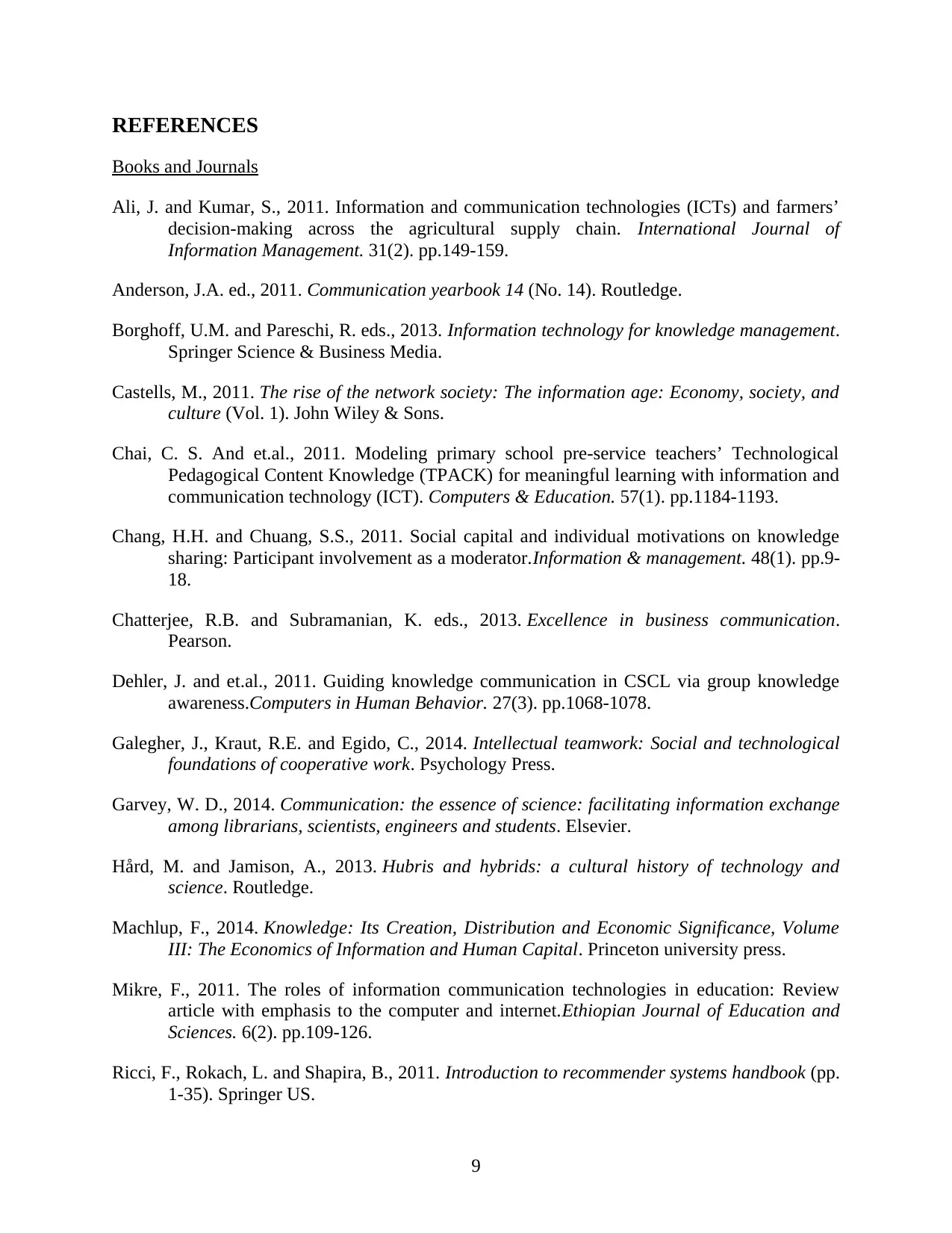
REFERENCES
Books and Journals
Ali, J. and Kumar, S., 2011. Information and communication technologies (ICTs) and farmers’
decision-making across the agricultural supply chain. International Journal of
Information Management. 31(2). pp.149-159.
Anderson, J.A. ed., 2011. Communication yearbook 14 (No. 14). Routledge.
Borghoff, U.M. and Pareschi, R. eds., 2013. Information technology for knowledge management.
Springer Science & Business Media.
Castells, M., 2011. The rise of the network society: The information age: Economy, society, and
culture (Vol. 1). John Wiley & Sons.
Chai, C. S. And et.al., 2011. Modeling primary school pre-service teachers’ Technological
Pedagogical Content Knowledge (TPACK) for meaningful learning with information and
communication technology (ICT). Computers & Education. 57(1). pp.1184-1193.
Chang, H.H. and Chuang, S.S., 2011. Social capital and individual motivations on knowledge
sharing: Participant involvement as a moderator.Information & management. 48(1). pp.9-
18.
Chatterjee, R.B. and Subramanian, K. eds., 2013. Excellence in business communication.
Pearson.
Dehler, J. and et.al., 2011. Guiding knowledge communication in CSCL via group knowledge
awareness.Computers in Human Behavior. 27(3). pp.1068-1078.
Galegher, J., Kraut, R.E. and Egido, C., 2014. Intellectual teamwork: Social and technological
foundations of cooperative work. Psychology Press.
Garvey, W. D., 2014. Communication: the essence of science: facilitating information exchange
among librarians, scientists, engineers and students. Elsevier.
Hård, M. and Jamison, A., 2013. Hubris and hybrids: a cultural history of technology and
science. Routledge.
Machlup, F., 2014. Knowledge: Its Creation, Distribution and Economic Significance, Volume
III: The Economics of Information and Human Capital. Princeton university press.
Mikre, F., 2011. The roles of information communication technologies in education: Review
article with emphasis to the computer and internet.Ethiopian Journal of Education and
Sciences. 6(2). pp.109-126.
Ricci, F., Rokach, L. and Shapira, B., 2011. Introduction to recommender systems handbook (pp.
1-35). Springer US.
9
Books and Journals
Ali, J. and Kumar, S., 2011. Information and communication technologies (ICTs) and farmers’
decision-making across the agricultural supply chain. International Journal of
Information Management. 31(2). pp.149-159.
Anderson, J.A. ed., 2011. Communication yearbook 14 (No. 14). Routledge.
Borghoff, U.M. and Pareschi, R. eds., 2013. Information technology for knowledge management.
Springer Science & Business Media.
Castells, M., 2011. The rise of the network society: The information age: Economy, society, and
culture (Vol. 1). John Wiley & Sons.
Chai, C. S. And et.al., 2011. Modeling primary school pre-service teachers’ Technological
Pedagogical Content Knowledge (TPACK) for meaningful learning with information and
communication technology (ICT). Computers & Education. 57(1). pp.1184-1193.
Chang, H.H. and Chuang, S.S., 2011. Social capital and individual motivations on knowledge
sharing: Participant involvement as a moderator.Information & management. 48(1). pp.9-
18.
Chatterjee, R.B. and Subramanian, K. eds., 2013. Excellence in business communication.
Pearson.
Dehler, J. and et.al., 2011. Guiding knowledge communication in CSCL via group knowledge
awareness.Computers in Human Behavior. 27(3). pp.1068-1078.
Galegher, J., Kraut, R.E. and Egido, C., 2014. Intellectual teamwork: Social and technological
foundations of cooperative work. Psychology Press.
Garvey, W. D., 2014. Communication: the essence of science: facilitating information exchange
among librarians, scientists, engineers and students. Elsevier.
Hård, M. and Jamison, A., 2013. Hubris and hybrids: a cultural history of technology and
science. Routledge.
Machlup, F., 2014. Knowledge: Its Creation, Distribution and Economic Significance, Volume
III: The Economics of Information and Human Capital. Princeton university press.
Mikre, F., 2011. The roles of information communication technologies in education: Review
article with emphasis to the computer and internet.Ethiopian Journal of Education and
Sciences. 6(2). pp.109-126.
Ricci, F., Rokach, L. and Shapira, B., 2011. Introduction to recommender systems handbook (pp.
1-35). Springer US.
9
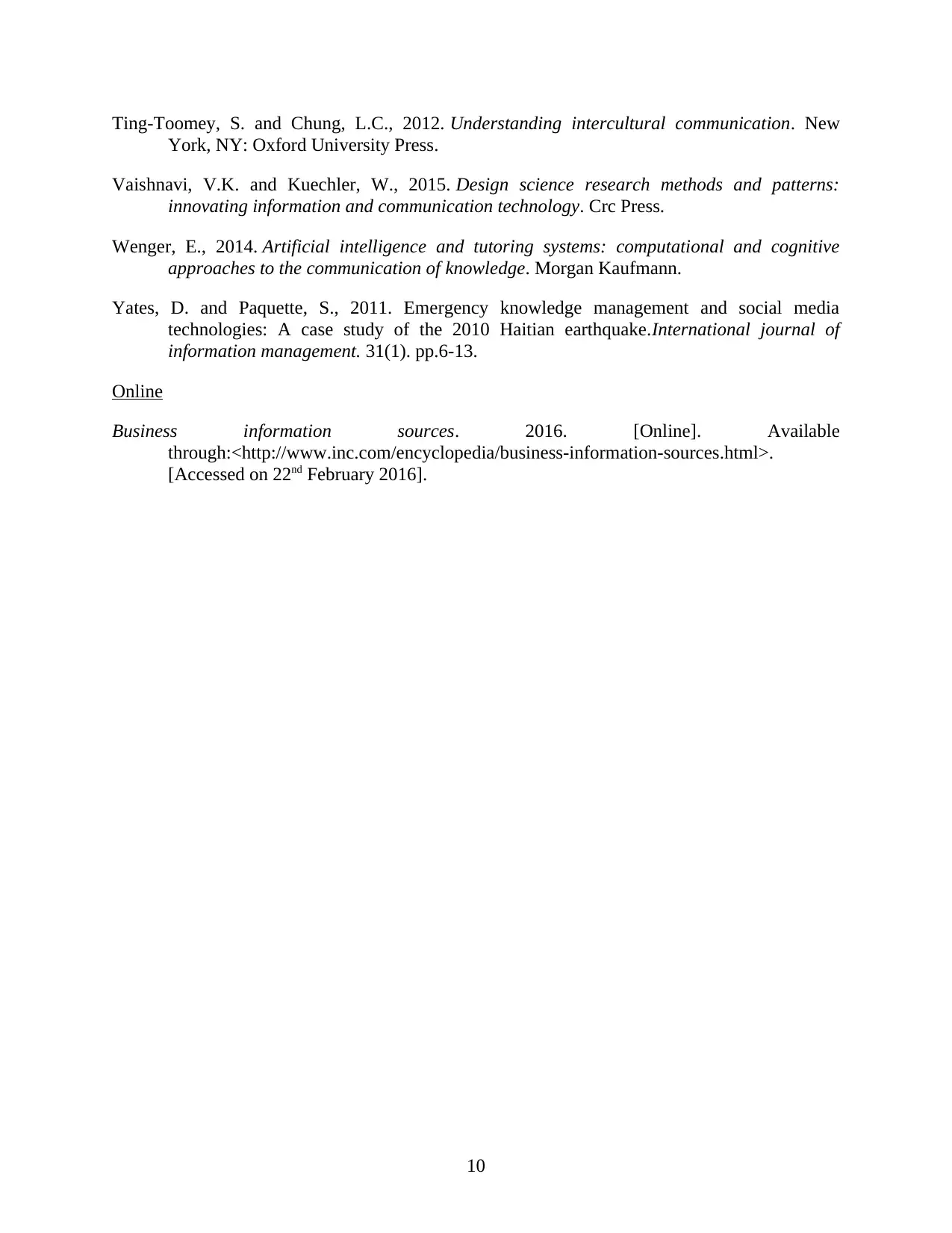
Ting-Toomey, S. and Chung, L.C., 2012. Understanding intercultural communication. New
York, NY: Oxford University Press.
Vaishnavi, V.K. and Kuechler, W., 2015. Design science research methods and patterns:
innovating information and communication technology. Crc Press.
Wenger, E., 2014. Artificial intelligence and tutoring systems: computational and cognitive
approaches to the communication of knowledge. Morgan Kaufmann.
Yates, D. and Paquette, S., 2011. Emergency knowledge management and social media
technologies: A case study of the 2010 Haitian earthquake.International journal of
information management. 31(1). pp.6-13.
Online
Business information sources. 2016. [Online]. Available
through:<http://www.inc.com/encyclopedia/business-information-sources.html>.
[Accessed on 22nd February 2016].
10
York, NY: Oxford University Press.
Vaishnavi, V.K. and Kuechler, W., 2015. Design science research methods and patterns:
innovating information and communication technology. Crc Press.
Wenger, E., 2014. Artificial intelligence and tutoring systems: computational and cognitive
approaches to the communication of knowledge. Morgan Kaufmann.
Yates, D. and Paquette, S., 2011. Emergency knowledge management and social media
technologies: A case study of the 2010 Haitian earthquake.International journal of
information management. 31(1). pp.6-13.
Online
Business information sources. 2016. [Online]. Available
through:<http://www.inc.com/encyclopedia/business-information-sources.html>.
[Accessed on 22nd February 2016].
10
⊘ This is a preview!⊘
Do you want full access?
Subscribe today to unlock all pages.

Trusted by 1+ million students worldwide
1 out of 12
Related Documents
Your All-in-One AI-Powered Toolkit for Academic Success.
+13062052269
info@desklib.com
Available 24*7 on WhatsApp / Email
![[object Object]](/_next/static/media/star-bottom.7253800d.svg)
Unlock your academic potential
© 2024 | Zucol Services PVT LTD | All rights reserved.





